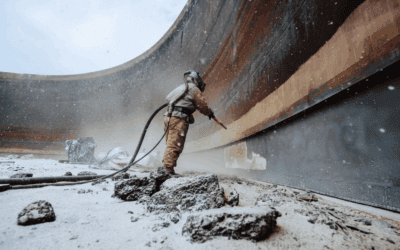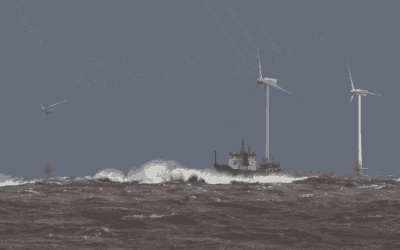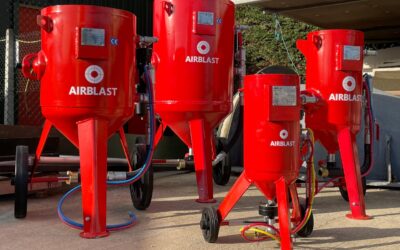How to achieve the perfect surface profile for coating adhesion
Poor surface preparation is one of the leading causes of coating failure – yet it's often overlooked.
Creating the right surface profile for coating adhesion is critical to ensuring the long-term performance of industrial coatings. Without it, even the most advanced coating systems can fail prematurely due to poor mechanical bonding.
The surface profile – also referred to as surface roughness, blast profile, or adhesion profile – describes the peaks and valleys created on a substrate, usually metal, during abrasive blasting. This roughened texture increases the surface area, giving the coating more to grip onto and improving adhesion strength and coating performance.
The aim of surface preparation is to create a profile that suits the coating system being applied. This requires good adhesion, durability, and long-term coating performance. Striking the right balance is essential – if the profile is too smooth, the coating may not adhere well; if it’s too rough, there’s a risk of excessive coating use, poor finish, or long-term degradation.
Key factors that influence surface profile
Several variables can affect the final coating surface profile:
- Abrasive type and size: Harder, more angular abrasives (like grit or aluminium oxide) create deeper profiles, while rounder media (like glass beads or plastic) produce smoother finishes. The size and hardness of the media should match the coating’s requirements. You can explore our range of abrasive media on our website for more information on which is best suited to your surface.
- Air pressure: Blasting pressure plays a critical role in determining surface profile and should be tailored to the substrate in use. For precise results, pressure should be measured at the nozzle using a hypodermic needle pressure gauge, rather than relying solely on the blast pot indicator.
- Blasting angle and technique: A consistent, 90-degree angle ensures a uniform surface texture. Irregular movements or angles can cause patchy preparation or inconsistent profile depth.
- Surface cleanliness: Even with the correct profile, coatings can fail if the surface is contaminated with oil, dust, oxidation, or moisture. Surface energy must be high to ensure proper chemical bonding between the substrate and the coating.
- Measurement tools: It’s essential to measure surface profile before coating. Common methods include:
- Replica tape: Captures a permanent impression of the profile for micrometer measurement.
- Surface profile gauges: Provide quick peak-to-valley readings using a mechanical or digital stylus.
- Comparator plates: Allow visual estimation against reference standards – useful in field settings.
These tools are typically used to measure Rz (average peak-to-valley) or Ra (average roughness), depending on specification requirements.
Matching surface profile to coating system
Different coatings require different surface profiles. For instance:
- Thin film coatings (like primers or alkyds) typically need a profile of 25–50 microns.
- High-build epoxies or zinc-rich primers often perform best with profiles around 50–75 microns.
- Heavy-duty protective coatings for marine or offshore use may demand even greater depths.
Always consult the coating manufacturer’s technical datasheet to ensure your surface preparation aligns with the product’s requirements. Mismatching a profile – for example, using a 100-micron profile for a coating designed for 40 microns – can lead to coating failure, increased material use, and unnecessary rework.
Contrary to popular belief, a higher surface profile does not always equate to better adhesion. Excessively rough surfaces can:
- Trap air or moisture.
- Increase the risk of “peak rusting” where high points corrode under the coating.
- Result in cracking or delamination.
Adhesion, cohesion, and failure modes
It’s important to distinguish between adhesion failure (coating detaches from the substrate) and cohesion failure (coating breaks within itself). Surface profile mainly affects adhesion, but issues like coating formulation, surface energy, and application conditions also play a role in performance.
Many coating failures begin at the profile peaks – particularly when over-blasting leads to micro-cracks or retained debris. Cleanliness is just as crucial as profile depth.
Common mistakes to avoid
- Over-blasting: This can cause excessive roughness, resulting in poor coating coverage, increased product usage, and accelerated corrosion at profile peaks.
- Under-blasting: A surface that’s too smooth won’t provide enough mechanical grip, leading to premature coating failure.
- Ignoring contaminants: Oil, dust, or moisture can remain trapped under the coating even on a correctly profiled surface.
- Skipping verification: Always verify the surface profile before and after blasting, especially when working to stringent specifications or in regulated environments.
Final thoughts
Achieving the right surface profile for coating adhesion is a critical step in protecting assets and ensuring long-term coating performance. Good surface preparation depends on more than just blasting – it requires the right abrasive, pressure, technique, and surface cleanliness, backed up by accurate measurement.
By understanding these variables and investing in proper preparation and verification, contractors and facility managers can prevent costly failures and deliver reliable, long-lasting results.
If you’re looking for advice on abrasive media or need blasting equipment, get in touch with our team – we’re happy to help.



